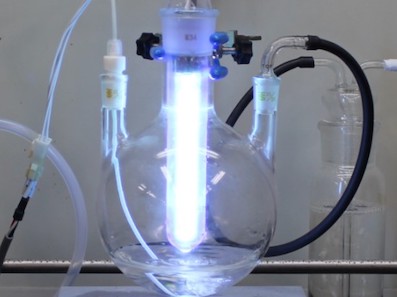 Cleanzine: your weekly cleaning and hygiene industry newsletter 17th October 2024 Issue no. 1134
Cleanzine: your weekly cleaning and hygiene industry newsletter 17th October 2024 Issue no. 1134
Your industry news - first
The original and best - for over 20 years!
We strongly recommend viewing Cleanzine full size in your web browser. Click our masthead above to visit our website version.
Dry-cleaning fluid becomes a synthetic chemist's treasure
 The widely used dry-cleaning and degreasing solvent, Tetrachloroethylene, (also known as Perchloroethylene, or Perc) can be converted to useful chemicals by a new clean, safe and inexpensive procedure.
The widely used dry-cleaning and degreasing solvent, Tetrachloroethylene, (also known as Perchloroethylene, or Perc) can be converted to useful chemicals by a new clean, safe and inexpensive procedure.
The Kobe University discovery - using on-demand UV activation, may open the path to upcycling the chemical, and thus contribute to a more sustainable society.
Organic synthesis is the production of useful chemicals, such as drugs, from other available chemicals. In general, chemists use source materials to create simple building blocks, such as carbonate esters, and combine them to increasingly complex structures. The source materials for this need to be reactive, but that also usually makes them toxic, such as the commonly used phosgene.
For this reason, chemists are constantly on the lookout for new source materials that are safer and more environmentally friendly while also retaining their reactivity. Ideally, they would like to use abundant and safe waste materials and turn them into useful products without that process also resulting in toxic by-products.
The Kobe University research group of Tsuda Akihiko specialises in the development of one-pot and flow organic synthesis using UV light. Such reactions have the advantages that they provide a closed environment in which harmless source materials can be photo-activated by the high-energy light on demand, eliminating the need for procuring or storing possibly toxic source materials; and that any reactive and thus possibly dangerous products can immediately be reacted further with other compounds, eliminating the need to extract them or the danger of their leaking into the environment.
The team has now built on its experience and partnered with the Japanese material manufacturer AGC to refine the process. Together, they focused on an attractive target, the commonly used degreasing and dry-cleaning agent Perc, or Perchloroethylene as chemists call it, which is non-harmful and produced in large quantities around the world.
Publishing in The Journal of Organic Chemistry, the academia-industry partnership describes a method to turn Perc into carbonate esters and chloroform, valuable building blocks for further organic synthesis, efficiently and in large quantities without any direct handling of toxic source materials such as phosgene.
"Because Perc is nonflammable and stable enough to be used as a solvent, its use as a raw material for organic synthesis has received little attention,” explains Tsuda. “However, using our original photo-on-demand organic synthesis method, we have succeeded for the first time in simultaneously obtaining industrially important carbonates and chloroforms from that source."
In addition, to further reduce the environmental impact of the system, the team tested replacing conventional mercury lamps that emit high-energy UV light with LED lamps generating mild UV light. While that required some modification of the reaction process, it could still successfully synthesise the desired products, opening up even greater potential to make organic synthesis more sustainable.
Tsuda is hopeful for the environmental impact of the new development. "It is a safe, inexpensive, simple and environmentally friendly chemical reaction,” he says. I expect that this new method of utilising and upcycling Perc, which is used in large quantities around the world, will be a significant step toward the realisation of a carbon neutral and sustainable society."
This research was supported by the Adaptable and Seamless Technology Transfer Program through Target-driven R&D (A-STEP) from the Japan Science and Technology Agency.
Image courtesy of Tsuda Akihiko, Associate Professor Graduate School of Science
18th January 2024







